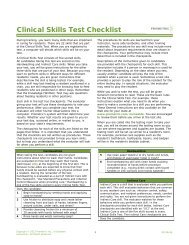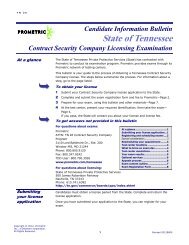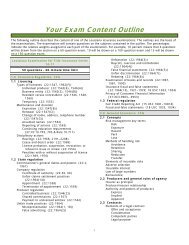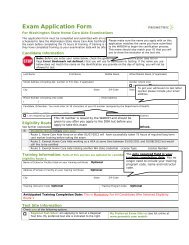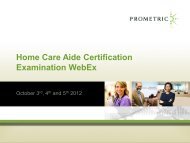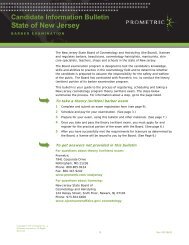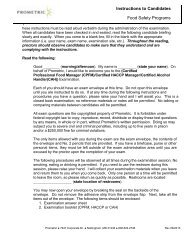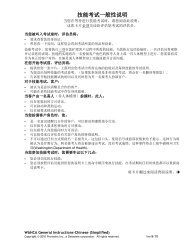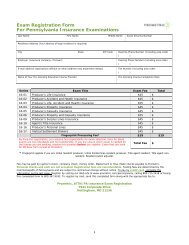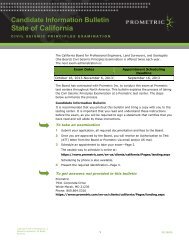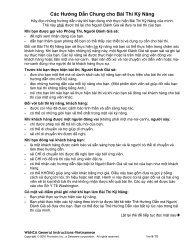Home Care Aide Skills Checklist - Prometric
Home Care Aide Skills Checklist - Prometric
Home Care Aide Skills Checklist - Prometric
Create successful ePaper yourself
Turn your PDF publications into a flip-book with our unique Google optimized e-Paper software.
<strong>Home</strong> <strong>Care</strong> <strong>Aide</strong> <strong>Skills</strong> <strong>Checklist</strong><br />
The following checklists contain the criteria used by the<br />
rater to evaluate each candidate’s performance for each<br />
of the skills included in the <strong>Skills</strong> Exam. Each checklist<br />
begins with a description of how the skill will be setup to<br />
simulate a client situation for testing purposes. The<br />
criteria are not necessarily listed in the order that a<br />
candidate would perform the skill.<br />
The checklists are not procedures and should not be<br />
used to learn the skills. The procedures for these skills<br />
are taught by training programs and can be found in<br />
textbooks (e.g., Revised Fundamentals of <strong>Care</strong>), and<br />
other learning materials. However, the checklists may<br />
be helpful for candidates and instructors in evaluating<br />
classroom performance.<br />
When administering the test, the evaluator watches the<br />
candidate perform the skill and compares each<br />
candidate’s performance to the checkpoints that make<br />
up the skill. Each checkpoint has a different value based<br />
on how critical it is to the safe performance of the skill.<br />
For example, the criteria for locking the wheelchair<br />
before transferring the client has a higher point value<br />
than the checkpoint for removing the gait belt at the<br />
end of the skill.<br />
The Washington State Department of Health has<br />
determined how many points are required to pass a<br />
skill. Their decisions are based on providing public<br />
protection.<br />
Candidates are required to pass all five skills to pass the<br />
test, but perfect performance is not required to pass a<br />
skill. The value assigned to each checkpoint is and how<br />
many points are required to pass a skill are secure test<br />
information. Even the evaluator who observes and<br />
records your performance does not know the value of<br />
each checkpoint or how many points it takes to pass a<br />
skill. The evaluator will enter the observations for a<br />
candidate’s performance in the computer, and the<br />
computer will score the exam.<br />
Handwashing Note: Your handwashing technique is<br />
evaluated at the beginning of the test. This skill is not<br />
prompted, which means you will not be told to wash<br />
your hands. <strong>Home</strong> care aides are expected to know to<br />
wash their hands before and after physical contact<br />
(touching) with the client. Demonstrating when<br />
handwashing is necessary is evaluated as a part of<br />
Common <strong>Care</strong> Practices.<br />
Common <strong>Care</strong> Practices are practices that are part of<br />
every skill, such as client rights, communication with<br />
the client, client safety and comfort, and infection<br />
control. Common <strong>Care</strong> Practices are rated during your<br />
performance of each skill. You will receive a separate<br />
score for Common <strong>Care</strong> Practices.<br />
Handwashing<br />
When the skills test begins, the candidate is evaluated on<br />
his/her handwashing technique. The candidate is not told<br />
to wash his/her hands, but is expected to know that<br />
before physical contact with the client, his/her hands<br />
should be washed.<br />
Does the candidate:<br />
1 wet hands and wrists under running water to begin<br />
cleansing?<br />
2 apply soap to hands to begin washing?<br />
3 lather all surfaces of hands and to wrists?<br />
4 use friction rubbing soapy hands together for<br />
a minimum of 20 seconds?<br />
5 rinse hands and wrists under running water to<br />
remove soap?<br />
6 keep hands pointed downward while washing and<br />
rinsing?<br />
7 use clean dry paper towel to dry hands and wrists?<br />
8 confine drying to areas washed?<br />
9 use paper towel to turn water off after hands<br />
cleansed?<br />
10 dispose of used paper towel in trash?<br />
11 end procedure with clean hands avoiding<br />
contamination (e.g., direct contact with faucet<br />
controls, paper towel dispenser, sink or trash<br />
can)?<br />
Common <strong>Care</strong> Practices<br />
Common <strong>Care</strong> Practices are behaviors or actions that are<br />
part of all care the home care aide (HCA) provides to the<br />
client. During the test, Common <strong>Care</strong> Practices are<br />
evaluated as a part of every skill the candidate performs.<br />
Does the candidate:<br />
1 identify self to the client when beginning care?<br />
2 use infection control measures and Standard<br />
Precautions to protect the client and the HCA<br />
throughout procedure?<br />
3 promote client's social and human needs<br />
throughout procedure?<br />
4 promote client's rights throughout procedure?<br />
5 promote client's safety throughout procedure?<br />
6 promote client's comfort throughout procedure?<br />
7 leave common use items within client's reach<br />
at end of care (e.g., phone, glasses, remote,<br />
tissues, glass of water)?<br />
Copyright © 2010 <strong>Prometric</strong> Inc., a Delaware<br />
corporation. All Rights Reserved.<br />
1 20100622
HOME CARE AIDE SKILLS CHECKLIST<br />
Help a Client to Take Medication<br />
17 promote client's rights throughout procedure?<br />
18 promote client's safety throughout procedure?<br />
19 promote client's comfort throughout procedure?<br />
20 leave common use items within client's reach at end<br />
of care (e.g., phone, glasses, remote, tissues, glass<br />
of water)?<br />
Provide Mouth <strong>Care</strong> to a Client<br />
The client is sitting at a table while this care is provided.<br />
The client is unable to brush his/her own teeth. The role<br />
of the client is played by another candidate.<br />
Does the candidate:<br />
1 identify self to the client when beginning care?<br />
2 apply clean gloves before brushing teeth?<br />
3 wet toothbrush with water before brushing<br />
client's teeth?<br />
4 apply toothpaste to toothbrush before brushing<br />
client's teeth?<br />
5 brush tops and side surfaces of client’s teeth?<br />
6 use gentle circular motions when brushing side<br />
surfaces of client’s teeth and gums?<br />
7 brush, or offer to brush, the client's tongue?<br />
8 provide client clean water in cup to rinse mouth?<br />
9 hold basin or a cup (separate cup) near client's chin<br />
to collect rinse water and spit?<br />
10 leave client's mouth area clean and dry at<br />
completion of mouth care?<br />
11 use barrier (e.g., towel) to protect client's clothing<br />
while providing mouth care and remove at<br />
completion of procedure?<br />
12 rinse and dry basin and rinse toothbrush<br />
before storing?<br />
13 dispose of used linen(s) and trash appropriately and<br />
leave overbed table dry at completion of procedure?<br />
14 remove gloves without contaminating self after<br />
rinsing and storing equipment?<br />
15 use infection control measures and Standard<br />
Precautions to protect the client and the HCA<br />
throughout procedure?<br />
16 promote client's social and human needs<br />
throughout procedure?<br />
17 promote client's rights throughout procedure?<br />
18 promote client's safety throughout procedure?<br />
19 promote client's comfort throughout procedure?<br />
20 leave common use items within client's reach at end<br />
of care (e.g., phone, glasses, remote, tissues, glass<br />
of water)?<br />
Clean and Store a Client’s Denture<br />
The client is sitting at a table or lying in bed while this<br />
care is provided. The client will hand the candidate a<br />
denture cup containing the denture. The role of the client<br />
is played by another candidate.<br />
Does the candidate:<br />
1 identify self to the client when beginning care?<br />
2 apply gloves before handling denture?<br />
3 use cool or tepid water when cleaning and rinsing<br />
denture?<br />
4 use toothpaste to cleanse denture?<br />
Clean and Store a Client’s Denture<br />
5 brush inner and outer surfaces of denture?<br />
6 rinse denture in water to remove toothpaste after<br />
brushing?<br />
7 place clean denture in denture cup filled with clean,<br />
cool or tepid clean water or denture solution?<br />
8 prevent contamination of denture throughout<br />
procedure (e.g., floating in sink water or setting<br />
denture directly on unprotected surface)?<br />
9 use technique to reduce the risk of denture<br />
breakage if dropped during cleaning (e.g.,<br />
brushing denture directly over sink lined with<br />
washcloth/paper towel/towel, filled with<br />
water, inside basin)?<br />
10 drain sink and remove liner (if used) at the end of<br />
skill?<br />
11 rinse toothbrush, store equipment, and dispose of<br />
trash and used linens appropriately?<br />
12 remove gloves without contaminating self after<br />
rinsing and storing equipment?<br />
13 use infection control measures and Standard<br />
Precautions to protect the client and the HCA<br />
throughout procedure?<br />
14 promote client's social and human needs<br />
throughout procedure?<br />
15 promote client's rights throughout procedure?<br />
16 promote client's safety throughout procedure?<br />
17 promote client's comfort throughout procedure?<br />
18 leave common use items within client's reach at end<br />
of care (e.g., phone, glasses, remote, tissues, glass<br />
of water)?<br />
Provide Fingernail and Hand <strong>Care</strong> to a Client<br />
The client is sitting at a table while this care is provided.<br />
For the test, the candidate is asked to provide care to<br />
only one hand. The role of the client is played by another<br />
candidate.<br />
Does the candidate:<br />
1 identify self to the client when beginning care?<br />
2 use water of safe temperature for soaking hand?<br />
3 ask client if water temperature is comfortable?<br />
4 soak client's fingers in basin of water before<br />
cleaning or shaping nails?<br />
5 dry client's hand, including between fingers,<br />
after removing from water and before cleaning<br />
under or shaping fingernails?<br />
6 dry client's hand by patting with towel, not rubbing?<br />
7 use orange stick to clean under fingernails and<br />
remove residue?<br />
8 wipe orange stick on towel to remove residue<br />
before cleaning under another fingernail?<br />
9 use emery board to file fingernails?<br />
10 leave fingernail tips smooth and free of rough<br />
edges?<br />
11 offer or apply hand lotion to hand after<br />
fingernail care is completed?<br />
12 wear gloves when providing fingernail care<br />
and while rinsing and drying equipment?<br />
13 store equipment, dispose of used linen(s) and trash<br />
appropriately and leave overbed table dry at<br />
completion of procedure?<br />
3 20100622
HOME CARE AIDE SKILLS CHECKLIST<br />
Provide Fingernail and Hand <strong>Care</strong> to a Client<br />
14 remove gloves without contaminating self<br />
after rinsing and storing equipment?<br />
15 use infection control measures and Standard<br />
Precautions to protect the client and the HCA<br />
throughout procedure?<br />
16 promote client's social and human needs<br />
throughout procedure?<br />
17 promote client's rights throughout procedure?<br />
18 promote client's safety throughout procedure?<br />
19 promote client's comfort throughout procedure?<br />
20 leave common use items within client's reach at end<br />
of care (e.g., phone, glasses, remote, tissues, glass<br />
of water)?<br />
Provide Foot <strong>Care</strong> to a Client<br />
The client is sitting in a chair while this care is provided.<br />
For the test, the candidate is asked to provide care to<br />
only one foot. The role of the client is played by another<br />
candidate.<br />
Does the candidate:<br />
1 identify self to the client when beginning care?<br />
2 observe condition of skin on foot separating<br />
toes to check between toes and turns foot to<br />
look at heels before beginning foot cleansing?<br />
3 soak client's foot in water contained in basin before<br />
cleaning or shaping toe nails?<br />
4 use water of safe temperature for soaking foot?<br />
5 ask client if water temperature is comfortable<br />
before foot completely submerged?<br />
6 submerge foot in water with basin filled to level<br />
sufficient to cover foot completely?<br />
7 keep water in basin soap-free for use as rinse<br />
water by: (1) washing foot with washcloth<br />
with soap applied directly to the washcloth<br />
instead of adding soap into basin of water; or<br />
(2) using two separate basins of water: one<br />
for washing and one rinsing?<br />
8 wash client's entire foot, including between toes<br />
with soapy washcloth after soaking?<br />
9 rinse to remove soap from foot and in between<br />
toes?<br />
10 dry client's foot, including between toes, after<br />
removing from water and before cleaning under or<br />
shaping toenails?<br />
11 dry client's foot by patting with towel, not rubbing?<br />
12 use orange stick to clean under nails and<br />
remove residue?<br />
13 wipe orange stick on towel to remove residue<br />
before cleaning under another toenail?<br />
14 use emery board to file toenails straight across?<br />
15 leave top edge of toenails smooth and free of rough<br />
edges?<br />
16 apply lotion to foot after nail care, avoiding<br />
lotion in between toes?<br />
17 wear gloves when providing foot care and<br />
while rinsing and drying equipment?<br />
18 store equipment, dispose of used linen(s) and trash<br />
appropriately and leave floor dry at completion of<br />
procedure?<br />
19 remove gloves without contaminating self<br />
after rinsing and storing equipment?<br />
Provide Foot <strong>Care</strong> to a Client<br />
20 use infection control measures and Standard<br />
Precautions to protect the client and the HCA<br />
throughout procedure?<br />
21 promote client's social and human needs<br />
throughout procedure?<br />
22 promote client's rights throughout procedure?<br />
23 promote client's safety throughout procedure?<br />
24 promote client's comfort throughout procedure?<br />
25 leave common use items within client's reach at end<br />
of care (e.g., phone, glasses, remote, tissues, glass<br />
of water)?<br />
Help Dress a Client who has a Weak Arm<br />
The client is sitting in a chair when care begins for this<br />
skill. The client is able to stand. The client is already<br />
wearing a clean T-shirt and underwear, and needs to be<br />
dressed in a shirt, pants, socks and shoes. The role of the<br />
client is played by another candidate, and for the test,<br />
will be dressed over his/her own clothing.<br />
Does the candidate:<br />
1 identify self to the client when beginning care?<br />
2 include client in choice about what to wear?<br />
3 place shirt sleeve over weak arm before putting on<br />
non-affected arm?<br />
4 cue client to assist with dressing?<br />
5 have client seated when putting feet and legs into<br />
pants?<br />
6 provide support to client when pulling up and<br />
securing pants?<br />
7 provide assistance to put socks and shoes on client<br />
while seated?<br />
8 leave socks smooth and shoes secured properly?<br />
9 move client's extremities gently and naturally,<br />
avoiding overextension when dressing?<br />
10 complete dressing with clothing secured and aligned<br />
properly?<br />
11 use infection control measures and Standard<br />
Precautions to protect the client and the HCA<br />
throughout procedure?<br />
12 promote client's social and human needs<br />
throughout procedure?<br />
13 promote client's rights throughout procedure?<br />
14 promote client's safety throughout procedure?<br />
15 promote client's comfort throughout procedure?<br />
16 leave common use items within client's reach at end<br />
of care (e.g., phone, glasses, remote, tissues, glass<br />
of water)?<br />
Put a Knee-high Stocking on a Client’s Leg<br />
The client is lying in bed when care begins for this skill.<br />
For this test, the candidate is asked to put the stocking<br />
on only one leg. The role of the client is played by<br />
another candidate.<br />
Does the candidate:<br />
1 identify self to the client when beginning care?<br />
2 prepare stocking for application by turning<br />
sock inside out to at least the heel area?<br />
3 place foot of stocking over toes, foot and heel?<br />
20100622 4
HOME CARE AIDE SKILLS CHECKLIST<br />
Put a Knee-high Stocking on a Client’s Leg<br />
4 complete application of stocking over foot<br />
with the toes and heel in proper position per<br />
stocking design?<br />
5 pull stocking up leg ensuring stocking is not<br />
twisted?<br />
6 leave stocking smooth (wrinkle-free)?<br />
7 leave room at toe area so that stocking is not tight<br />
against toes?<br />
8 leave stocking raised to knee?<br />
9 move client's leg gently, supporting extremity,<br />
and avoiding overextension, when applying<br />
elastic stocking?<br />
10 use infection control measures and Standard<br />
Precautions to protect the client and the HCA<br />
throughout procedure?<br />
11 promote client's social and human needs<br />
throughout procedure?<br />
12 promote client's rights throughout procedure?<br />
13 promote client's safety throughout procedure?<br />
14 promote client's comfort throughout procedure?<br />
15 leave common use items within client's reach at end<br />
of care (e.g., phone, glasses, remote, tissues, glass<br />
of water)?<br />
Provide Passive Range of Motion (ROM) Exercises<br />
to Client’s Shoulder, Knee and Ankle<br />
The client is lying in bed when the care begins for this<br />
skill. For this test, the candidate is asked to provide<br />
exercises to only one side of the body. The role of the<br />
client is played by another candidate.<br />
Does the candidate:<br />
1 identify self to the client when beginning care?<br />
2 support the client's arm holding under elbow<br />
and wrist joints areas while exercising<br />
shoulder?<br />
3 raise client's straightened arm from bed towards<br />
head of bed (HOB) and return back towards bed as<br />
one repetition (shoulder flexion/extension)?<br />
4 move client's straightened arm away from side<br />
of body towards HOB and return toward side<br />
as one repetition (shoulder<br />
abduction/adduction)?<br />
5 provide rotation exercise to the shoulder?<br />
6 support the client's knee and ankle joints while<br />
exercising knee?<br />
7 bend the client's knee back to point of resistance<br />
and then follow by straightening knee as one<br />
repetition (knee flexion/extension)?<br />
8 support the client's ankle, holding under ankle area<br />
and foot, while exercising ankle?<br />
9 push the foot forward towards leg, and in separate<br />
motion push the foot pointed down toward the foot<br />
of bed (FOB), as one repetition (ankle<br />
flexion/extension)?<br />
10 provide three (3) repetitions of each shoulder, knee<br />
and ankle ROM exercise?<br />
11 ask client about comfort level throughout exercises?<br />
12 provide controlled, slow, gentle movements when<br />
exercising shoulder, knee and ankle?<br />
Provide Passive Range of Motion (ROM) Exercises<br />
to Client’s Shoulder, Knee and Ankle<br />
13 use infection control measures and Standard<br />
Precautions to protect the client and the HCA<br />
throughout procedure?<br />
14 promote client's social and human needs<br />
throughout procedure?<br />
15 promote client's rights throughout procedure?<br />
16 promote client's safety throughout procedure?<br />
17 promote client's comfort throughout procedure?<br />
18 leave common use items within client's reach at end<br />
of care (e.g., phone, glasses, remote, tissues, glass<br />
of water)?<br />
Provide Perineal <strong>Care</strong> to a Female Client<br />
The client is lying in bed while this care is provided. The<br />
client is unable to assist with this care. Perineal care is<br />
provided using soap and water. For this test, the client is<br />
a female mannequin.<br />
Does the candidate:<br />
1 identify self to the client when beginning care?<br />
2 use water that is a safe temperature to cleanse<br />
client?<br />
3 apply gloves before cleansing perineal area?<br />
4 use pad or towel to protect bottom sheet from<br />
becoming wet during procedure?<br />
5 use soapy washcloth to cleanse perineal area?<br />
6 use clean area on washcloth for each washing and<br />
rinsing stroke?<br />
7 wipe perineal area from front to back for all<br />
cleansing and rinsing strokes?<br />
8 keep water in basin soap-free for use as rinse water<br />
by: (1) washing with washcloth with soap applied<br />
directly to the washcloth instead of adding soap into<br />
basin of water; or (2) using two separate basins of<br />
water: one for washing and one rinsing?<br />
9 rinse perineal area using a soap-free clean wet<br />
washcloth or soap-free area of the washcloth used<br />
to cleanse?<br />
10 dry perineal area by patting with towel moving<br />
from front to back?<br />
11 provide cleansing, rinsing and drying to include<br />
labial folds and extending into groin (skin-fold)<br />
area?<br />
12 position client a safe distance from edge of<br />
bed when turned on side during care?<br />
13 wash, rinse and dry peri-anal area and<br />
buttocks?<br />
14 wipe from front to back when washing, rinsing<br />
and drying peri-anal area?<br />
15 leave client on dry underpad or sheet at completion<br />
of procedure?<br />
16 minimize exposure of the client's body during<br />
the procedure?<br />
17 wear gloves while providing perineal care, while<br />
rinsing and drying equipment, and handling soiled<br />
linens?<br />
18 rinse, dry and store basin, dispose of used linen(s)<br />
and trash appropriately at completion of procedure?<br />
19 remove gloves without contaminating self<br />
after rinsing and storing equipment?<br />
5 20100622
HOME CARE AIDE SKILLS CHECKLIST<br />
Provide Perineal <strong>Care</strong> to a Female Client<br />
20 leave client covered with top sheet at completion of<br />
procedure?<br />
21 use infection control measures and Standard<br />
Precautions to protect the client and the HCA<br />
throughout procedure?<br />
22 promote client's social and human needs<br />
throughout procedure?<br />
23 promote client's rights throughout procedure?<br />
24 promote client's safety throughout procedure?<br />
25 promote client's comfort throughout procedure?<br />
26 leave common use items within client's reach at end<br />
of care (e.g., phone, glasses, remote, tissues, glass<br />
of water)?<br />
Provide Catheter <strong>Care</strong> to a Client with an<br />
Inserted Urinary Catheter<br />
The client is lying in bed while this care is provided. The<br />
client is unable to assist with this care. Catheter care is<br />
provided using soap and water. For this test, the client is<br />
a mannequin.<br />
Does the candidate:<br />
1 identify self to the client when beginning care?<br />
2 use water that is a safe temperature to cleanse<br />
client?<br />
3 apply gloves before handling catheter, tubing,<br />
urinary drainage bag or beginning cleansing?<br />
4 use soapy washcloth to cleanse catheter?<br />
5 change spot on washcloth for each washing<br />
and rinsing stroke?<br />
6 cleanse and rinse catheter using wet<br />
washcloth moving in one direction from the<br />
opening (meatus) and downward away from<br />
the body?<br />
7 keep water in basin soap-free for use as rinse water<br />
by: (1) washing with washcloth with soap applied<br />
directly to the washcloth instead of adding soap into<br />
basin of water; or (2) using two separate basins of<br />
water: one for washing and one rinsing?<br />
8 wash and rinse at least 4" of catheter from<br />
opening (meatus) downward?<br />
9 rinse cleansed area of catheter using a clean,<br />
wet, soap-free washcloth or soap-free clean<br />
area of the washcloth used to cleanse?<br />
10 hold catheter near opening (meatus) to prevent<br />
tugging when washing and rinsing catheter?<br />
11 leave skin areas that became wet during care<br />
and bed sheets dry at completion of<br />
procedure?<br />
12 dry skin areas by patting?<br />
13 leave catheter tubing free of kinks at completion of<br />
procedure?<br />
14 keep urinary drainage bag positioned lower than<br />
bladder throughout care and at end of procedure?<br />
15 minimize exposure of the client's body during<br />
the procedure?<br />
16 position client a safe distance from edge of bed if<br />
turned on side during care?<br />
17 wear gloves while providing catheter care, while<br />
rinsing and drying equipment and handling soiled<br />
linens?<br />
Provide Catheter <strong>Care</strong> to a Client with an<br />
Inserted Urinary Catheter<br />
18 rinse, dry and store basin, dispose of used linen(s)<br />
and trash appropriately at completion of procedure?<br />
19 remove gloves without contaminating self<br />
after rinsing and storing equipment?<br />
20 leave client covered with top sheet at completion of<br />
procedure?<br />
21 use infection control measures and Standard<br />
Precautions to protect the client and the HCA<br />
throughout procedure?<br />
22 promote client's social and human needs<br />
throughout procedure?<br />
23 promote client's rights throughout procedure?<br />
24 promote client's safety throughout procedure?<br />
25 promote client's comfort throughout procedure?<br />
26 leave common use items within client's reach at end<br />
of care (e.g., phone, glasses, remote, tissues, glass<br />
of water)?<br />
Transfer a Client from a Bed into a Wheelchair<br />
The client is lying in bed when care begins for this skill.<br />
The client can bear weight, but cannot walk. The client’s<br />
transfer requires a transfer (gait) belt. The role of the<br />
client is played by another candidate.<br />
Does the candidate:<br />
1 identify self to the client when beginning care?<br />
2 have wheelchair positioned near bed before<br />
assisting the client to sit?<br />
3 assist client to apply non-skid footwear before<br />
standing?<br />
4 provide support holding behind client's shoulders or<br />
back, and hips to help client sit up at edge of bed?<br />
5 apply transfer (gait) belt before standing client for<br />
transfer to wheelchair?<br />
6 apply transfer (gait) belt over clothing with fit<br />
to allow for placement of flat hand only<br />
between belt and client's body?<br />
7 position wheelchair to allow for pivot with front<br />
interior wheel at side of bed, with chair parallel or<br />
slightly angled, before beginning transfer?<br />
8 have the client's feet (wearing shoes)<br />
positioned flat on the floor before standing?<br />
9 ensure footrests raised, removed or swung out of<br />
way before transferring client into wheelchair?<br />
10 lock wheels before beginning transfer?<br />
11 brace one or both of client's lower extremities when<br />
assisting to stand?<br />
12 grasp gait belt on sides or around back when<br />
assisting client to stand and throughout transfer?<br />
13 cue client to stand?<br />
14 turn client upon standing so that back of legs are<br />
positioned centered against seat of wheelchair?<br />
15 cue client to hold onto armrest(s) before<br />
sitting in wheelchair?<br />
16 provide controlled gentle lowering into wheelchair<br />
seat?<br />
17 complete transfer with client's hips positioned<br />
against the back of the wheelchair seat?<br />
18 leave client seated in wheelchair in proper<br />
body alignment and with feet repositioned on<br />
footrests?<br />
20100622 6
HOME CARE AIDE SKILLS CHECKLIST<br />
Transfer a Client from a Bed into a Wheelchair<br />
19 remove gait belt after transfer complete?<br />
20 use infection control measures and Standard<br />
Precautions to protect the client and the HCA<br />
throughout procedure?<br />
21 promote client's social and human needs<br />
throughout procedure?<br />
22 promote client's rights throughout procedure?<br />
23 promote client's safety throughout procedure?<br />
24 promote client's comfort throughout procedure?<br />
25 leave common use items within client's reach at end<br />
of care (e.g., phone, glasses, remote, tissues, glass<br />
of water)?<br />
Turn and Reposition a Client who Must Stay in Bed,<br />
Onto His/Her Side<br />
The client is lying on his/her back in bed when care<br />
begins for this skill. The client needs help to turn and<br />
support to remain in a side-lying position. The role of the<br />
client is played by another candidate.<br />
Does the candidate:<br />
1 identify self to the client when beginning care?<br />
2 hold client at hip and shoulder area when turning<br />
onto side?<br />
3 position client a safe distance from edge of<br />
bed when turned onto side?<br />
4 position device (e.g., padding, pillow) against<br />
back rolled and tucked to maintain client's<br />
side-lying position?<br />
5 leave client in side-lying position, avoiding direct<br />
pressure on hipbone?<br />
Turn and Reposition a Client who Must Stay in Bed,<br />
Onto His/Her Side<br />
6 use device (e.g., padding, pillow) to support top<br />
leg?<br />
7 use device (e.g., padding, pillow) to maintain<br />
alignment of top hip?<br />
8 leave top knee flexed?<br />
9 leave ankles and knees separated?<br />
10 leave client in side-lying position with head<br />
supported by pillow?<br />
11 leave client’s lower arm and shoulder free from<br />
being tucked under side?<br />
12 support upper arm using padding or pillow?<br />
13 leave client covered with top sheet at completion of<br />
procedure?<br />
14 use infection control measures and Standard<br />
Precautions to protect the client and the HCA<br />
throughout procedure?<br />
15 promote client's social and human needs<br />
throughout procedure?<br />
16 promote client's rights throughout procedure?<br />
17 promote client's safety throughout procedure?<br />
18 promote client's comfort throughout procedure?<br />
19 leave common use items within client's reach at end<br />
of care (e.g., phone, glasses, remote, tissues, glass<br />
of water)?<br />
7 20100622



